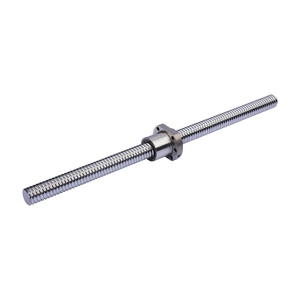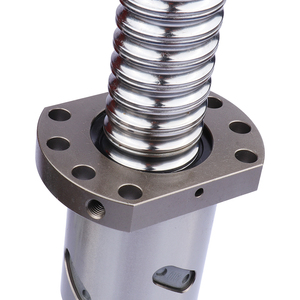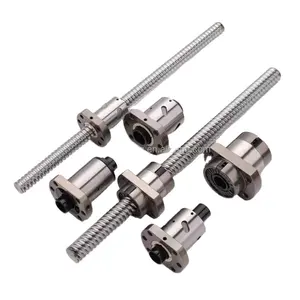(7643 products available)










































































































































































































Market Overview: The global precision ballscrew market was valued at approximately $1.6 billion in 2023 and is projected to reach $2.3 billion by 2032, reflecting a robust compound annual growth rate (CAGR) of 4.1% during the forecast period. This growth is largely driven by increasing automation and the adoption of advanced manufacturing technologies across various industries, including automotive and aerospace. Notably, the Asia-Pacific region, particularly China, is expected to lead this expansion, thanks to rapid industrialization and a surge in demand for high-precision manufacturing solutions. According to industry reports, China's precision ballscrew market is anticipated to grow at an impressive rate, aligning with the country's overall economic development and technological advancements.
Competitive Landscape: Major players in the precision ballscrew market are focusing on innovation and strategic partnerships to enhance their market presence. Companies like Hiwin Corporation and NSK Ltd. are continuously developing advanced precision ballscrew solutions tailored to meet the evolving demands of high-tech industries. The demand for precision ballscrews is particularly pronounced in sectors requiring exact motion control, such as CNC machinery and robotics. As industries prioritize energy efficiency and productivity, the transition from traditional hydraulic systems to electric actuators powered by precision ballscrews is becoming increasingly prevalent. This shift not only improves operational efficiency but also addresses customer pain points related to maintenance and reliability, positioning the precision ballscrew market for sustained growth in the coming years.
A ballscrew is a screw design component used to convert rotational motion into linear motion and provide low-friction movement. It is mainly used in machinery industry equipment such as CNC machines, lathes, and other high-precision equipment. The following are typical types of ballscrews:
Return-Style Ballscrew
A return-Style ballscrew is a ballscrew design in which the ball bearings travel along a return channel. This channel is separate from the ball groove. This distinct return path allows the ball bearings to loop back to the beginning of their journey on the screw shaft. The layout enhances predictability and functionality. This design is often found in short or medium-length screws where space conservation is key.The Return-Style Ballscrew offers a few big-time benefits. First off, it cuts down on friction, which means things can move super smoothly. Also, because the balls are always in the same spot, users can expect consistent performance every time. This design is a popular pick for precision-guiding applications where accuracy really matters.
Double-Start Ballscrew
A Double-Start Ballscrew has two parallel threads running through it. These threads work together to boost effective lead, meaning users can get more movement per turn. This setup also makes for shorter axial lengths so the screw can fit into tighter spaces. With its combined efficiency and compactness, the Double-Start Ballscrew shines in applications that need to save room but still offer high-speed and high-precision movement.
Return-Without-Threads (Compact)
Unlike the typical ones, this ballscrew does not have return threads. The balls travel through a bend inside a plastic/metal tube. This setup reduces the length and diameter of the assembly, making it easier to install in tight spots. Despite being able to cut down on space, Compact Ballscrews may need to be inspected or lubricated frequently, unlike standard models. Still, the small size is great for jobs that are short on room but need solid performance.
Using a special plastic or metal tube for the balls to travel through really shrinks the size of the screw. This design is perfect for tight areas where things need to be small. However, Compact Ballscrews can be harder to access for maintenance compared to others.
Return-In-A-Single-Circuit (Circulated)
Circulated Ballscrews offer ball circulation in a single loop by utilizing end caps. This unique design makes end machining easier and significantly reduces overall length. Circulated Ballscrews excel in applications requiring compact size and light weight.
The following specifications are crucial when the China ballscrew is either supported or being selected for installation.
The following preventive maintenance steps are necessary to ensure that the ballscrew works perfectly and the machine is adequately supported.
Ballscrews play an integral role in the functioning of machines in the industries mentioned below.
Manufacturing Industry
In the manufacturing industry, heavy machines usually require moving loads to have precise movements. In this case, like it is done with CNC machines, ballscrews are mostly used because they offer precise control of machine parts. That said, it is worth mentioning that other pieces of equipment, like lathes and routers, also utilize this component for the same reason.
Solar Industry
The solar industry makes use of ballscrews in solar trackers. What they do here is allow the photovoltaic panels to follow the sun's movement throughout the day. This will ensure that maximum solar energy is harvested. Note that this usually improves the efficiency of the solar system by a certain percentage.
Robotics and Automation
As mentioned earlier in a previous section, ballscrews provide linear motion and high-precision positioning for robotic arms in an assembly machine. This is true for every assembly machine, whether in the electronics, automotive, or even manufacturing industry. Aside from robotic arms, other machines that use ballscrews for the same purpose are pick-and-place machines, Cartesian robots, and rotary robots, to name a few.
Aerospace & Defense
The aerospace and defense industry employs the use of high-precision anti-backlash ballscrew in critical areas like flight control surfaces, actuators, and engine control valves, just to name a few. The reason for this is to allow precise control and positioning.
Medical and Healthcare
Medical equipment usually needs precise movement and control system and sometimes even require high loads but low speeds. According to this, medical equipment like MRI machines, X-ray machines, and even surgical robots make use of a ballscrew. A good example of this is that they help in the accurate positioning of imaging components or even patient tables.
These tips are ideal for those looking to invest in quality ballscrews for their machinery.
Load Capacity and Factor of Safety:
Know the load capacity of the current application. Select a capsules ballscrew with a factor of safety that is ideal for the application.
Friction and Efficiency:
Consider the friction between the nut and screw. Go for higher efficiency ballscrews even if they have a higher price.
Preload:
Decide the level of preload required after weighing the tradeoff between rigidity and unwanted axial friction.
Nut Design:
Opt for a counteracting axial load design nut if there is a high axial load in the application. Also, consider a self-retaining nut for vertical positioning.
Dust Prevention:
Prevent dust from damaging the ballscrew. Use dust covers or seals to avoid environmental damage to the screw.
Mounting Options:
Check the mounting options if there is a need for adapter at the end fittings. The ballscrew should have several mounting options for easier customization.
Q1: What is the main difference between a ballscrew and a leadscrew?
A1: The main difference between a ballscrew and a leadscrew is the type of screw circulating element. While the generally simple and commonly used screw thread relies on sliding friction to move loads, a ballscrew uses ball bearings to reduce friction.
Q2: Are ballscrews durable?
A2: Ballscrews are much more durable than ordinary leadscrews because the ball's rolling motion produces less friction than a simple sliding mechanism, resulting in lower wear over time.
Q3: Which application is ideal for high-load ballscrews?
High-load ballscrews are designed for applications requiring greater load capacity, such as aerospace, medical, and semiconductor applications. Such heavy-duty ballscrews typically have larger-diameter ball screws, more significant ball diameters, and higher-number circuits to divide the load effectively.
Q4: What affects the life and performance of a ballscrew?
A4: Several factors will affect the life and performance of a ballscrew, including choices of material and surface treatment, the quality of its ball assembly, and fitting precision. Selecting the appropriate preload will also affect its performance.
Q5: Do China ballscrews need regular lubrication?
A5: Yes. Lubrication reduces friction between the balls and the raceway. Regular lubrication can extend the service life of the ballscrew and ensure its smooth operation.